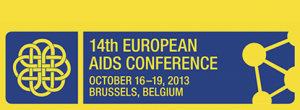Bone turnover marker changes early in ART predict bone loss after 96 week
1 December 2013. Related: Conference reports, Coinfections and complications, EACS 14 Brussels 2013.
 Mark Mascolini, for NATAP.org
Mark Mascolini, for NATAP.org
Changes in markers of bone resorption (destruction) and formation early in the course of antiretroviral therapy (ART) predicted clinically significantly bone loss after 96 weeks of treatment in a trial that randomised people to either raltegravir or tenofovir/emtricitabine (TDF/FTC), both with lopinavir/ritonavir. [1]
Adding to the complexity of bone marker studies, results of this analysis indicated that greater increases in bone formation markers through 16 weeks of treatment were associated with clinically meaningful BMD loss at week 96.
Previous research has reported that bone mineral density (BMD) drops 2% to 6% in the 2 years after antiretroviral therapy begins regardless of the antiretrovirals taken [2]. When treatment starts,bone resorption markers increase faster than bone formation markers, creating what these researchers call a “catabolic window.” Because it remains unclear whether early changes in turnover markers predict antiretroviral-associated bone loss, these investigators addressed that question in PROGRESS study participants.
PROGRESS randomised 206 antiretroviral-naive adults to start either raltegravir or TDF/FTC with lopinavir/ritonavir. Seventy-eight people in the raltegravir arm and 82 in the TDF/FTC arm completed the study and had baseline and week-96 DXA scans to measure BMD. At baseline and weeks 4, 16, 48, and 96,researchers measured type 1 C-terminus telopeptide (CTx, a bone resorption marker),osteocalcin,procollagen type 1 propeptide (P1NP),and bone-specific alkaline phosphatase (BSAP) (all bone formation markers). The primary goal was to determine the impact of marker changes on clinically significant bone loss,defined as at least a 5% decrease in total BMD at week 96.
Among people included in the bone turnover analysis,about 90% were men,about 80% were white, and almost half smoked. Age averaged about 40 years in both groups and body mass index about 25 kg/m(2). Two thirds of study participants drank alcohol. Through 96 weeks of treatment,total BMD remained essentially stable in the raltegravir group (+0.68%) while dropping in the TDF/FTC group (-2.48%) (P < 0.001).
Levels of CTx, the resorption (destruction) marker,lay in the mid-normal range at baseline and rose significantly in both treatment arms through 96 weeks. Levels of osteocalcin,a bone formation marker,started in the low-normal range and also climbed significantly in both arms. Levels of P1NP and BSAP lay in the normal range at baseline and did not change much through 96 weeks of treatment in either arm. CTx and osteocalcin levels rose significantly more with TDF/FTC than with raltegravir over 96 weeks.
Nineteen of 160 study participants (11.9%) had 5% or greater total BMD loss through 96 weeks, including 3 of 78 in the raltegravir group and 16 of 82 in the TDF/FTC group,a significant difference (3.8% versus 19.5%, p = 0.003). In a logistic regression model that did not include the antiretroviral effect, two nonmarker factors were associated with lower odds of at least a 5% loss in total BMD (age under 40 and male gender) and two nonmarker factors were associated with higher odds of more than 5% bone loss (white race and baseline CD4 count below 200).
In this analysis, the impact of baseline bone marker levels and early bone marker changes were complex. For CTx, the bone resorption marker,higher baseline levels and greater change over 4 weeks were both linked to at least 5% total BMD loss at week 96. But greater week-4 increases in the bone formation markers P1NP, osteocalcin,and BSAP generally protected against 96-week bone loss, although only the P1NP change reached statistical significance. After 16 weeks of treatment, however,larger changes in the bone formation markers P1NP and osteocalcin were positively associated with bone loss,a result suggesting to the investigators that these markers reflect overall bone turnover rather than just bone formation.
In the analysis including antiretroviral treatment effect,younger age and male gender remained protective against week-96 bone loss of 5% or more,while white race and baseline CD4 count below 200 again raised the odds of week-96 bone loss. And once again higher baseline CTx and greater absolute change in CTx through treatment week 4 were associated with higher odds of total BMD loss at week 96. Associations between baseline bone formation markers and changes at weeks 4 and 16 were all similar to those associations in the analysis excluding treatment effect and approached or achieved statistical significance. In this analysis treatment with raltegravir versus TDF/FTC did not significantly protect against 96-week bone loss,a result suggesting to the investigators that antiretroviral differences in impact on bone loss can largely be attributed to changes in bone turnover markers.
All told, the PROGRESS investigators proposed,”these data provide evidence supporting the hypothesis that early relative changes in markers of bone resorption and bone formation (i.e., the catabolic window) are important predictors of bone loss in HIV positive persons” starting antiretroviral therapy. They called for further study of the mechanisms behind this effect and the effects of individual antiretrovirals on bone turnover.
References:
- Brown Tet al. Decreased total bone mineral density in treatment-naive subjects taking lopinavir/ritonavir combined with raltegravir or tenofovir/emtricitabine. 14th European AIDS Conference, 16-19 October2013, Brussels. Abstract PS7/5.
http://www.eacsmobile.org/libraryEntry/show/378893720398094313 - McComsey GAet al. Bone disease in HIV infection: a practical review and recommendations for HIV care providers. Clin Infect Dis. 2010;51:937-946.
http://cid.oxfordjournals.org/content/51/8/937.long

